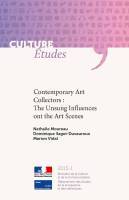Nathalie MOUREAU, Dominique SAGOT-DUVAUROUX, Marion VIDAL
April 2015
22 p.
What is a collector? Although the French term collectionneur was first officially recorded in the dictionary in 1789, its definition covers a range of different practices: for some, the main emphasis is on an item's subjective value, whilst others focus more closely on the accumulation and selection process. Whether they collect shells, stamps, butterflies or works of art, collectors share a number of things in common.
However, those who support “emerging” art have a more varied set of practices than those generally observed in their counterparts. In addition to simply being a buyer, the contemporary art collector has the ability to influence the artistic life, especially through the material support provided to artists and by contributing to the construction of artistic value. This particular characteristic is all the more notable as the collector's involvement in artistic life is not solely the prerogative of a narrow wealthy elite, as the collector profiles here demonstrate.
Indeed it seems that collector practices may fall anywhere across a scale which ranges from the acquisitive collector, motivated by the desire to possess a across a scale which ranges from the acquisitive collector, motivated by the desire to possess a work, to the actor collector, for whom the actual acquisition of a work is merely the expression of his willingness to contribute to the vitality of the artistic scene.


